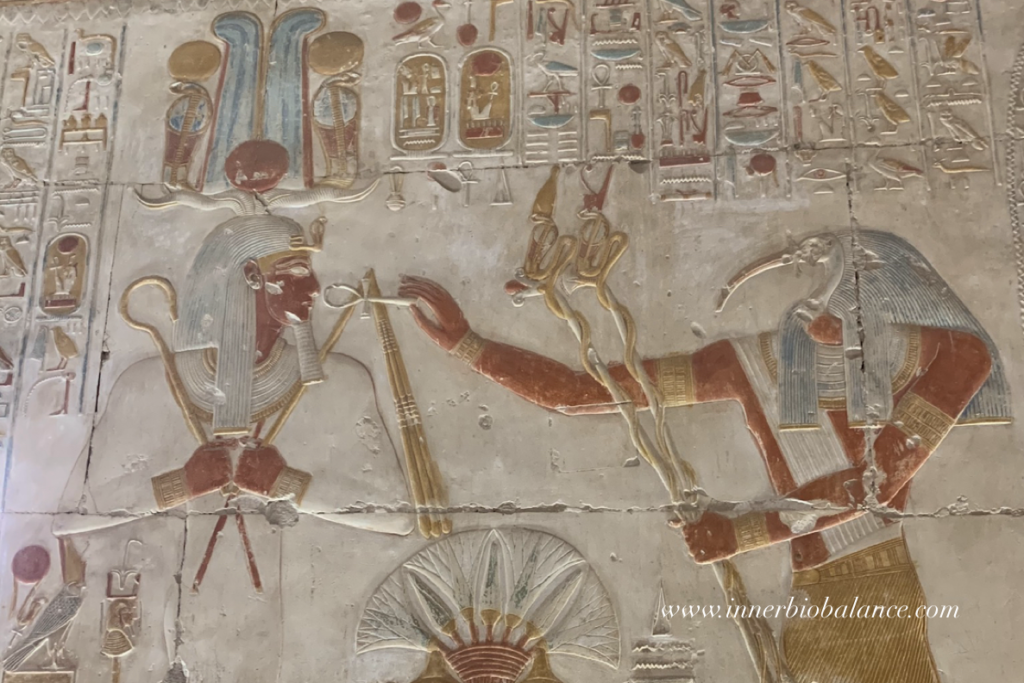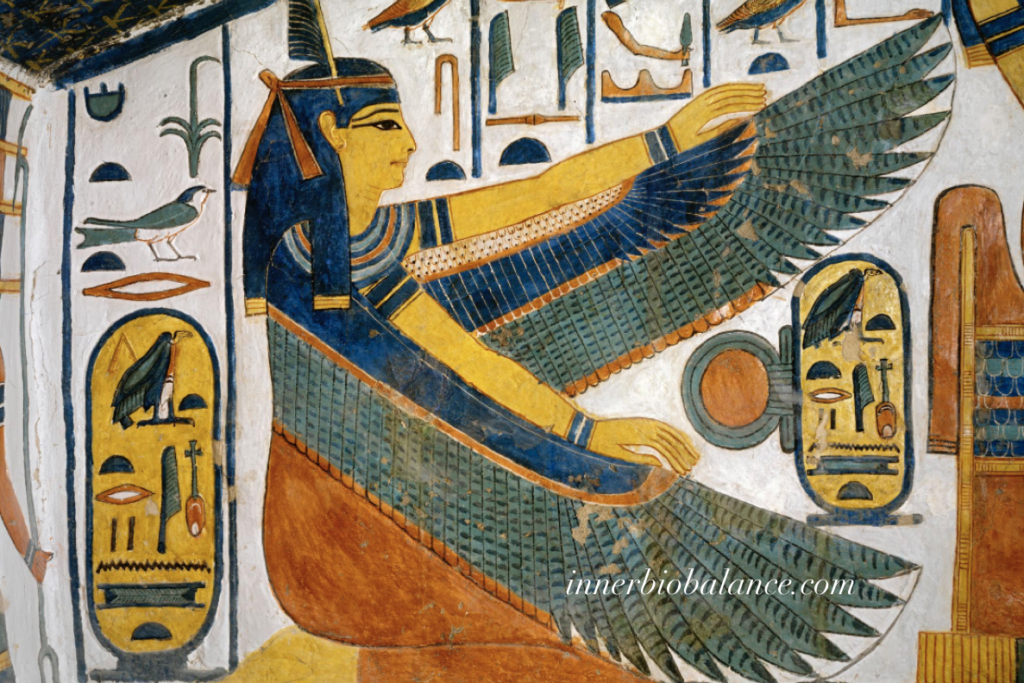
The origins of writing
Writing is one of humanity’s greatest inventions. By giving a material form to spoken language, people could store and transmit information across space and time. It was revolutionary, a time capsule.
Writing was invented independently in at least four different times and places: Mesopotamia, Egypt, China, and Mesoamerica. Of these original writing systems, Egyptian and Sumerian are the oldest known. On top of the impact created by recording and passing information through generations, writing became an important wellbeing tool supporting emotional balance in everyday life.
The pen of Thoth, Egyptian royal scribe
In ancient Egypt, Thoth was the protector god of writing and creative activities involving music, healing, sacred geometry, astronomy, magic and the moon. His name means “he, who is like the ibis”, a bird considered sacred in ancient Egypt. He is often depicted as a man with an ibis head or as a baboon.
Thoth was the masculine god of balance, associated with the feminine goddess Ma’at and the principle of divine equilibrium. He wrote the Book of Life and was in charge of the measurement of time, judgement and destiny. The pen of Thoth was mightier than the sword and like the feather of Ma’at, was weighted in the scales of balance next to the heart of the deceased.
Pen and feather played dual roles as writing tools and instruments to gauge if a soul could pass or not into the afterlife. Ma’at and Thoth represented the original epitome of Yin and Yang source energies, working independently and yet together, co-creating and supporting the same goal of balancing daily life and afterlife.
My handwriting experience as a healing tool
I am, and have always been, deeply in love with handwriting and journaling. Even when I fell ill as a little girl, my main comfort was instinctively to express my pain by writing imaginary stories about my teddies or nature having superpowers to heal me. In my early twenties, writing to myself gave my feelings a voice to integrate the sudden death of my mother and my own near-death experience and rebirth.
At a time of shock when I was offered medicinal and recreational drugs to mask my initial pain, I turned my attention away from all things medical or numbing. I let my body guide me in a slow and natural way through writing, singing, dancing and crying how to integrate the various phases of my visiting feelings. I went through a first shock, denial, victimhood, sadness, anger, acceptance, a second shock, re-birth, awakening, inner knowing, awareness of being loved beyond any type of earthly love, self-empowerment, self-discipline, determination, achievement and gratitude.
I found most answers came by means of expressing my feelings to myself and were accelerated due to the NDE rebirth. This is why I recommend my clients to practice journaling as a self-love, healing practice to join their left and right brain, root in the now, assist in giving closure and integrate their feelings.
Calligraphy and cursive: two writing styles
I admire the aesthetic aspect of handwriting such as calligraphy and while living in the Middle East, I’ve fallen in love with Arabic calligraphy also known as “khatt”. Resembling some activating light language symbols, I was very happy to know that khatt was added to UNESCO’S cultural heritage list in 2023.
Calligraphy is an ancient art of drawing with letters, using specific, slow strokes and lifting the pen after each stroke. Our feelings can have a direct effect on how the letters and symbols are arranged and the rhythm and flow between them. The purpose is to create beautiful handwriting and artistic scripts. As it requires a slower pace than cursive handwriting, people often find calligraphy very relaxing, like painting.
Cursive is another type of handwriting that children learn in school. Its purpose is to write legibly and quickly by avoiding lifting the pen off the page, resulting in letters that are connected. Cursive is what we use to write and sign our names. Do you know that, sadly, some schools no longer teach cursive?
Cursive handwriting supports early years brain development
Most humans have their predominant language centre in the left hemisphere of the brain. However, signatures and other graphic pictograms are usually managed in the right hemisphere. How interesting.
The brain pathways involved in typing a “letter already formed” are different from those involved in drawing a letter “stroke by stroke”. Writing by hand is a slower and more elaborate process that promotes deep coding of information and makes learning much more consolidated. Handwriting boosts our creativity, emotions and flow (right brain), connects left brain with right brain and plays an important role in early years brain development.
In recent years, we have seen a trend to introduce typewriting from early educational years, to the detriment of cursive handwriting and creativity. Some countries like Finland have dropped handwriting lessons in schools in favor of typing courses. In the majority of the US, the requirement to learn cursive has been left out of core standards since 2013. As a result, many adults already have real problems to read cursive and are incapable of signing their names unless they use a digital fingerprint or scribble.
Have we, as a society, asked ourselves why this trend? The use of typewriting is fast and convenient for work purposes. But the extreme trend to digitize our lives is decreasing the development of cognitive abilities, particularly in children. It teaches children from early age to become less critical and more compliant adults. Who is benefiting from this trend? Learning cursive handwriting is a priority for physical, mental and emotional health that all children should have access to.
Journaling as therapeutic handwriting
When clients come to me in search of a treatment, the majority have one thing in common. They seek support for a physical complain. Talking about negative emotions, even if they are aware of them, is not perceived as a priority. Some clients can not cope with too many emotions being uncovered at once. This is why journaling and non-verbal therapies like somatic massage can be so beneficial due to being gentle.
Therapeutic handwriting consists of dedicating between 15 to 30 minutes a day to personal, emotion-focused writing to help us connect with, recognize and manage our feelings. Those who do it regularly get physical and psychological benefits such as better immune function and less anxiety and depression.
Many physical symptoms have been found to have an emotional root cause. This is why by journaling daily our thoughts and emotions, we support our physical and emotional health. The importance of journaling daily is that, over time, we can find out a pattern that otherwise may go unnoticed. It is from those repetitive old patterns that we can learn better how to move forward.
Connecting left and right brain hemispheres to heal PTSD and learn about our soul mission
In recent years we have heard reports of trauma survivors like Cathy O’Brien candidly explaining the way handwriting has helped her overcome extreme PTSD. Her testimony serves as great encouragement to others. O’Brien has authored various books to state that writing with a pen is a real boost for the brain as different parts get active, inter-connected and this inter-connection is what heals us. When I read this, a vision of a pen and a feather came to me as if to confirm the power of unity inside.
Moving a pen requires the left, logic part of the brain, the critical analysis part of the brain, to move that pen. This willingness to write, unlocks the right brain holding the emotionally incomprehensible, unprocessed trauma and shifts it over to logic awareness, to be written out on paper where is then consciously seen, critically analysed, processed and healing takes place on numerous levels.
At this point, any fear-based mind control or negative indoctrination/repetition done by others does not work, as the brain is capable of retaining free thought and critical discernment beyond the trauma. Wouldn’t make sense to educate people from early age on the benefits of handwriting for brain development? Isn’t it amazing that thanks to a humble pen -or feather- we can gain key awareness to support our own healing and become adults capable of sustaining brain coherence?
Journaling our daily life is pretty much similar to journaling our dreams as soon as we wake up, so that we remember and learn more about ourselves and potentially, our soul mission. As the nursery rhyme goes “life is but a dream”, it takes us to consider if we perceive ourselves mostly as a human living a life or as eternal spirit dreaming one of many human lives/dreams, whose patterns we increasingly inter-connect as we handwrite them. What soul journeys will those patterns take us to? For those who wish to dive deeper into their subconscious mind beyond the recording of their dreams, quantum healing hypnosis can be extremely supportive. We have all the answers within.

